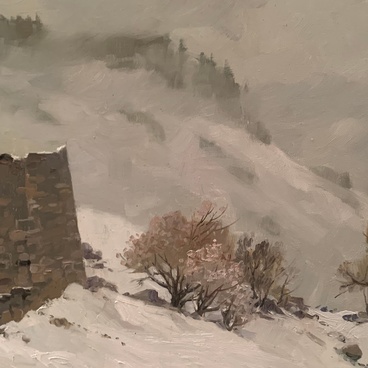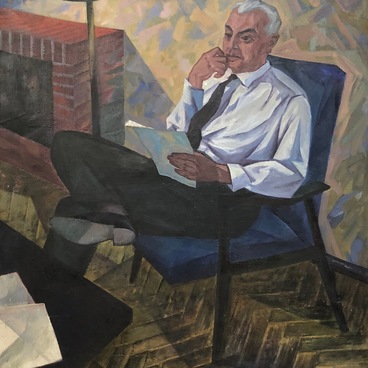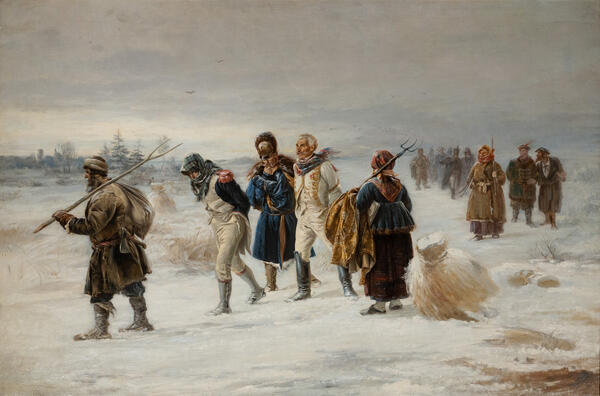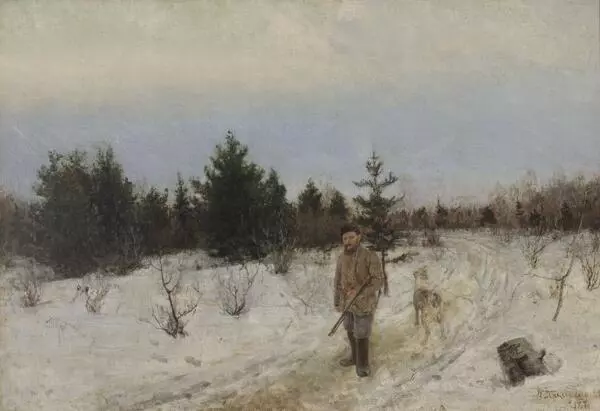Illarion Pryanishnikov painted the picture Children in work time in 1900. He depicted village children who are absorbed in playing outdoor games. They are throwing a small ball between them. The two boys, sitting on the sidelines are talking. The painter captured a nice summer day. He used light paints in his work. The children’s clothes are covered in sunlight. Because of this lighting, their simple shirts seem elegant.
Pryanishnikov’s paintings almost always depict an attractive story and a lot of details that are interesting to ponder on. He painted the costumes of ordinary people and their activities in detail. His paintings are a fascinating story of Russian life in the second half of the 19th century.
Back in 1865, Illarion Pryanishnikov received a large silver medal and the title of class artist of the 3rd degree for his genre painting Jokers. Gostiny Dvor in Moscow. The work was sent to the International Exhibition in Vienna, but the audience did no get to see it, after all. According to art critic Vladimir Stasov, the decision was taken not to exhibit it ‘because of fear of showing our social ills to Europe.’
At the end of 1869 Pryanishnikov was actively involved in creating the Association of Mobile Art Exhibitions. He became a founding member of the organization and widely participated in expositions. The Itinerants contrasted themselves against the Academy of Arts – they elected not depict the idealized subjects and began to turn to real life and the daily life of the people.
The master created a lot of canvases on a variety of subjects during his artistic career. He often depicted scenes from city life - this is reflected in his paintings At the Puppet Theater, Wandering Minstrels and The Seamstress. Together with his fellow artists he also created a series of canvases dedicated to the defense of Sevastopol in the Crimean War - the artist painted eighteen canvases out of the total of ninety-seven.
Pryanishnikov did several monumental canvases in the 1880s-1890s, dedicated to the life and traditions of the Russian villages. They include The Day of the Savior in the North, The Procession of the Cross, and The Common Sacrificial Vessels on Patron Saint’s Day.
Pryanishnikov’s paintings almost always depict an attractive story and a lot of details that are interesting to ponder on. He painted the costumes of ordinary people and their activities in detail. His paintings are a fascinating story of Russian life in the second half of the 19th century.
Back in 1865, Illarion Pryanishnikov received a large silver medal and the title of class artist of the 3rd degree for his genre painting Jokers. Gostiny Dvor in Moscow. The work was sent to the International Exhibition in Vienna, but the audience did no get to see it, after all. According to art critic Vladimir Stasov, the decision was taken not to exhibit it ‘because of fear of showing our social ills to Europe.’
At the end of 1869 Pryanishnikov was actively involved in creating the Association of Mobile Art Exhibitions. He became a founding member of the organization and widely participated in expositions. The Itinerants contrasted themselves against the Academy of Arts – they elected not depict the idealized subjects and began to turn to real life and the daily life of the people.
The master created a lot of canvases on a variety of subjects during his artistic career. He often depicted scenes from city life - this is reflected in his paintings At the Puppet Theater, Wandering Minstrels and The Seamstress. Together with his fellow artists he also created a series of canvases dedicated to the defense of Sevastopol in the Crimean War - the artist painted eighteen canvases out of the total of ninety-seven.
Pryanishnikov did several monumental canvases in the 1880s-1890s, dedicated to the life and traditions of the Russian villages. They include The Day of the Savior in the North, The Procession of the Cross, and The Common Sacrificial Vessels on Patron Saint’s Day.







